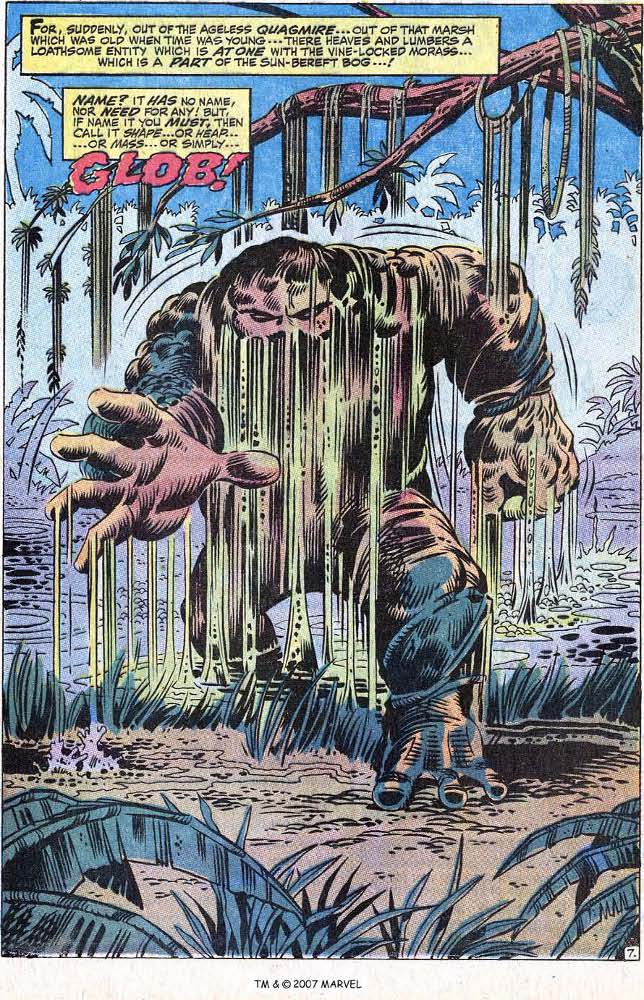 Roy Thomas has long been a champion of the Heap. His career has been entwined with it. In 1969, he created a one-off villain for the incredible Hulk to fight, called the Glob. It was his first full writing assignment. In The Incredible Hulk # 121 (“Within the Swamp There Stirs... A Glob” November, 1969), The Hulk throws radioactive barrels into a swamp, which inevitably leads to the resurrection of some thing in the swamp. Ladies and gentlemen, meet the Glob.
Roy Thomas has long been a champion of the Heap. His career has been entwined with it. In 1969, he created a one-off villain for the incredible Hulk to fight, called the Glob. It was his first full writing assignment. In The Incredible Hulk # 121 (“Within the Swamp There Stirs... A Glob” November, 1969), The Hulk throws radioactive barrels into a swamp, which inevitably leads to the resurrection of some thing in the swamp. Ladies and gentlemen, meet the Glob.According to his introduction to Heap Vol 1, Thomas originally wanted to call his creation the Shape, but Stan Lee though that sounded too feminine. The Glob is the first character to be written by many names that will become familiar as I go through the Heap's progeny. Roy Thomas, Steve Gerber, and Len Wein have all used the Glob.
The Glob shares certain similarities to the Heap. Swamp-derived, inhumanly strong, but it’s also mute, inhumanly tough, and uniquely, shaggy. The Heap could recognize events from its past, as if through fog, never able to truly think in words, as far as we could tell. The Glob’s mental faculties are similar, unable to reason, unable to think. is able to , it seems can think in words and images. Except for the flashback that shows the Glob’s origin, it seems to work on the same instinctual level the Heap did. Interestingly Herb Trimpe was the illustrator for Marvel's Phantom Eagle, a WWI flyer.
Joe Timms, the human who becomes the Glob, wasn’t a pilot. He was an escaped prisoner who blundered into quicksand, and drowned. And there is an echo of the Heap's language about the will to live being strong enough. Like von Emmelmann the human that was the Glob lay in the swamp for decades, before an outside catalyst, something like The Mad Heap’s life formula, seeps into the swamp, leading to Joe Timms’ monstrous rebirth.
 It's no longer sufficient for the dead man to have possessed unbreakable will, or get the help of the baby ghosts of Walcaw swamp: Heap offshoots often need an exterior catalyst to explain their transmogrification. For the Glob, it's the Hulk's destruction of a warehouse full of drums of radioactive waste. The stories being set in swamps, this is usually a liquid. Later muck men will be acted upon by experimental chemicals, the super soldier serum, biorestorative formulae, and necroplasm.
It's no longer sufficient for the dead man to have possessed unbreakable will, or get the help of the baby ghosts of Walcaw swamp: Heap offshoots often need an exterior catalyst to explain their transmogrification. For the Glob, it's the Hulk's destruction of a warehouse full of drums of radioactive waste. The stories being set in swamps, this is usually a liquid. Later muck men will be acted upon by experimental chemicals, the super soldier serum, biorestorative formulae, and necroplasm.Thomas says in his essay that the Hulk is also a derivative of the Heap, being super strong, green, and invulnerable to bullets. Although I'm not convinced myself, his idea is explored in the comic. The Hulk and the Glob are mistaken for each other, and when one is anticipated, the other shows up.
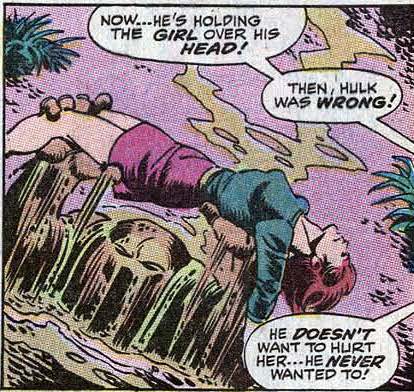 The Glob’s initial storyline is pretty by the numbers. The Hulk wanders into a swamp fleeing the military, and encounters the Glob. The Glob, acting on dim memories of a wife, is attempting to carry away a woman. When he begins to dissolve in a radioactive swamp, he holds the woman up, showing to the Hulk that killing her is not his aim. The hulk rescues her, and the Glob vanishes beneath the surface.
The Glob’s initial storyline is pretty by the numbers. The Hulk wanders into a swamp fleeing the military, and encounters the Glob. The Glob, acting on dim memories of a wife, is attempting to carry away a woman. When he begins to dissolve in a radioactive swamp, he holds the woman up, showing to the Hulk that killing her is not his aim. The hulk rescues her, and the Glob vanishes beneath the surface.What’s interesting about this story is that the Hulk the putative hero of the story, fights the Glob mostly because the Glob won’t speak to him. When they work in tandem to rescue the woman from the radioactive water, the Hulk realizes his mistake.
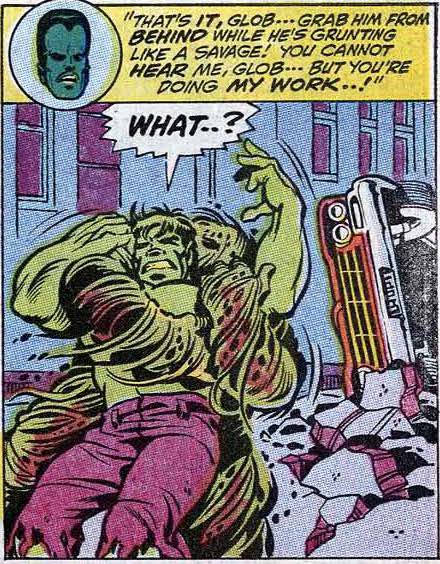 Less than a year later, the Glob was back, reconstituted by green supergenius The Leader. In Incredible Hulk #129 (“Again, the Glob”, July 1970) the Glob is little more than a determined pawn, mind-controlled into attacking the Hulk. This appearance doesn't show much about the Glob, since his personality is subsumed into the Leader's control. Nevertheless, he is a determined opponent that even the Incredible Hulk really can't damage. The Hulk eventually has to electrocute the Glob in order to stop its unstoppable attacks. Even so, the little bits of the Glob that are left begin to come together, and the comic leaves it there. It's not an issue that does a lot of development.
Less than a year later, the Glob was back, reconstituted by green supergenius The Leader. In Incredible Hulk #129 (“Again, the Glob”, July 1970) the Glob is little more than a determined pawn, mind-controlled into attacking the Hulk. This appearance doesn't show much about the Glob, since his personality is subsumed into the Leader's control. Nevertheless, he is a determined opponent that even the Incredible Hulk really can't damage. The Hulk eventually has to electrocute the Glob in order to stop its unstoppable attacks. Even so, the little bits of the Glob that are left begin to come together, and the comic leaves it there. It's not an issue that does a lot of development. Of course, this all changed when Steve Gerber gets his hands on the character. Gerber introduced the Glob in Giant-Sized Man-Thing #1 (“How Will We Keep Warm When the Last Flame Dies?”, August, 1974). Sort of. Joe Timms' brain has been rescued from the swamp by the Cult of Entropy. This is all that's left of him, but it's a golden brain, capable of projecting the Glob. Two pages later, this new, projected fights the Man-Thing and loses. Timms' golden brain is again naked and alone, sinking in the swamp.
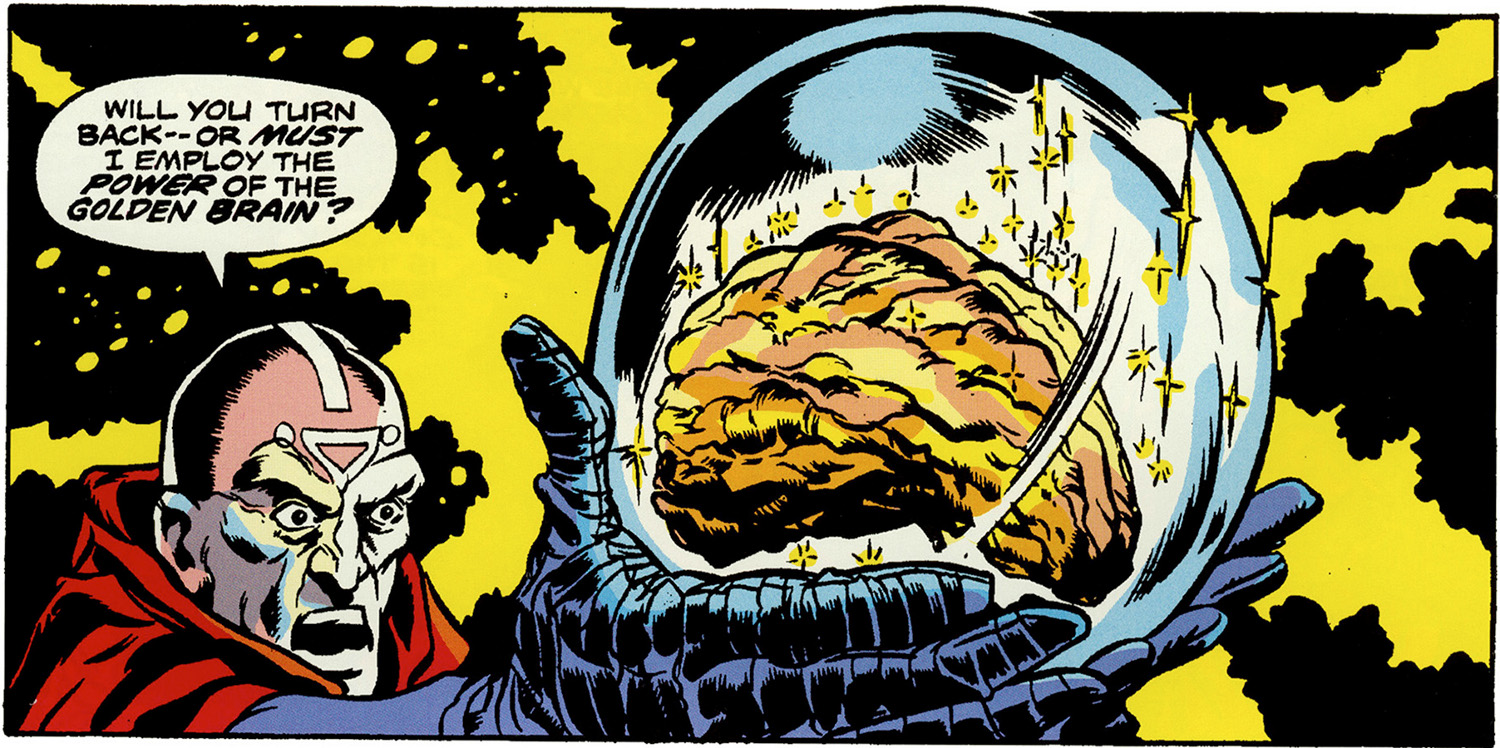 But this is Steve Gerber we're discussing. I'll write more, a lot more, on his work on Man-Thing pretty soon. Let me just say that Gerber had a brilliant writer with a constant and amazing stream of ideas. The Golden Brain builds itself a new, familiar body out of mud, Joe Timms, to be precise. But like the Glob and the Heap, he cannot speak. Simple and thoughtless, he it put to work until the leader of the Cult of Entropy forces him to become the Glob again. But now the Glob is mucky, rather than the shaggy creature. Once again mind-controlled, the Glob now attacks the Man-Thing.
But this is Steve Gerber we're discussing. I'll write more, a lot more, on his work on Man-Thing pretty soon. Let me just say that Gerber had a brilliant writer with a constant and amazing stream of ideas. The Golden Brain builds itself a new, familiar body out of mud, Joe Timms, to be precise. But like the Glob and the Heap, he cannot speak. Simple and thoughtless, he it put to work until the leader of the Cult of Entropy forces him to become the Glob again. But now the Glob is mucky, rather than the shaggy creature. Once again mind-controlled, the Glob now attacks the Man-Thing.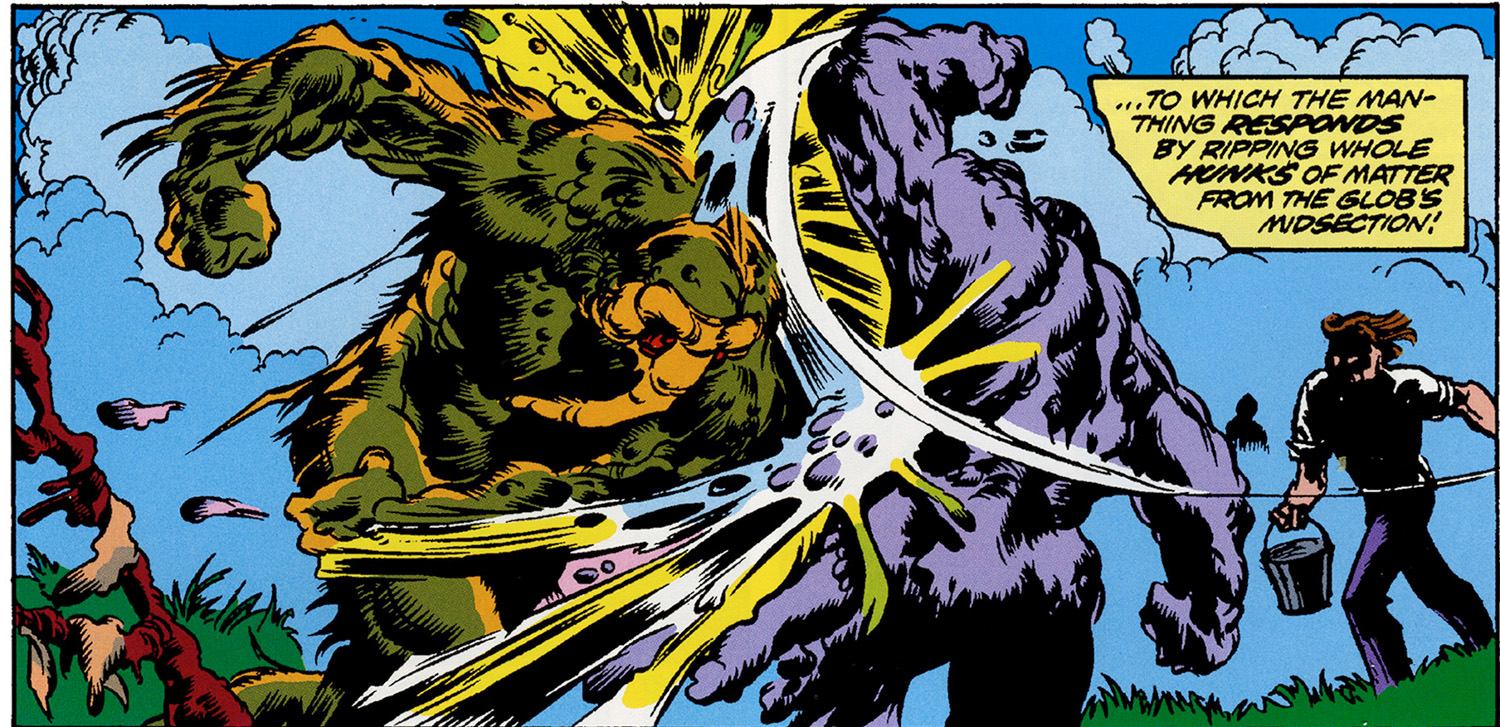 Poor Glob is once again subject to mind control when he reappears in Incredible Hulk 197 and 198 (“...And Man-Thing Makes Three” and “The Shangri-La Syndrome”, March and April 1976, respectively). The writer is notably Len Wein. Wein, perhaps best known to me as the creator of Swamp Thing, wrote that title until 1974. Two years later, he took another dip in the swamps in in two Hulk issues.
Poor Glob is once again subject to mind control when he reappears in Incredible Hulk 197 and 198 (“...And Man-Thing Makes Three” and “The Shangri-La Syndrome”, March and April 1976, respectively). The writer is notably Len Wein. Wein, perhaps best known to me as the creator of Swamp Thing, wrote that title until 1974. Two years later, he took another dip in the swamps in in two Hulk issues.Joe Timms has once again resumed his mute, human form. But another mind-control expert, this time the Collector, turns him back into the clay-like Glob. Alongside the similarly-dominated Man-Thing, the two muck monsters defeat the Hulk.
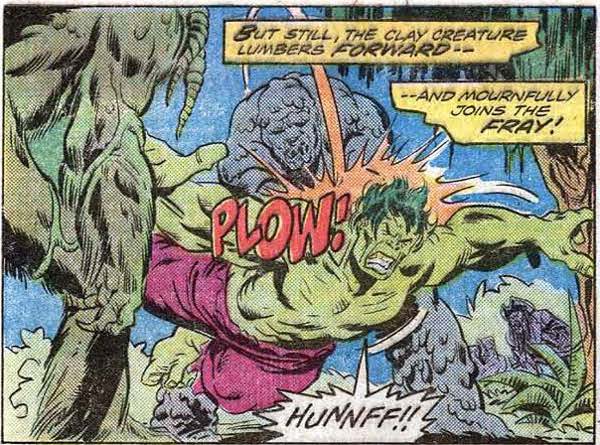 The Glob doesn't have much to do for the rest of the story. But it is part of the successful rebellion, and it is the Glob that attacks the Collector in the end of the story. Poor Glob is probably feeling ill-used, after being manipulated by the Leader, the Cult of Entropy, and now Collector. Small wonder he wants to take it out on his most recent tormentor.
The Glob doesn't have much to do for the rest of the story. But it is part of the successful rebellion, and it is the Glob that attacks the Collector in the end of the story. Poor Glob is probably feeling ill-used, after being manipulated by the Leader, the Cult of Entropy, and now Collector. Small wonder he wants to take it out on his most recent tormentor.Sixteen years later, writer Tom Field and artist Gary Barker reintroduced the Glob in Incredible Hulk # 389 (“Of Man and Man-Thing”, January 1992). But this Glob is not Timms. Instead, a scientist named Samuel Beckwith, attempting to discover Ted Sallis (the Man-Thing)’s version of the supersoldier formula, injects himself it.
This Glob has nothing to do with the swamp, aside from living there. Apparently, what makes this Glob is the serum. Sallis burned and ran into the swamp, but there’s no indication that Beckwith had any accidents or external forces aside from the serum. Why it turns him into the Glob… we don’t know. But the appearance is exactly the same as the clay Glob from the Steve Gerber and Len Wein stories. I wonder why the new Beckwith version was necessary, unless writer Tom Field didn't want to destroy Roy Thomas's work.
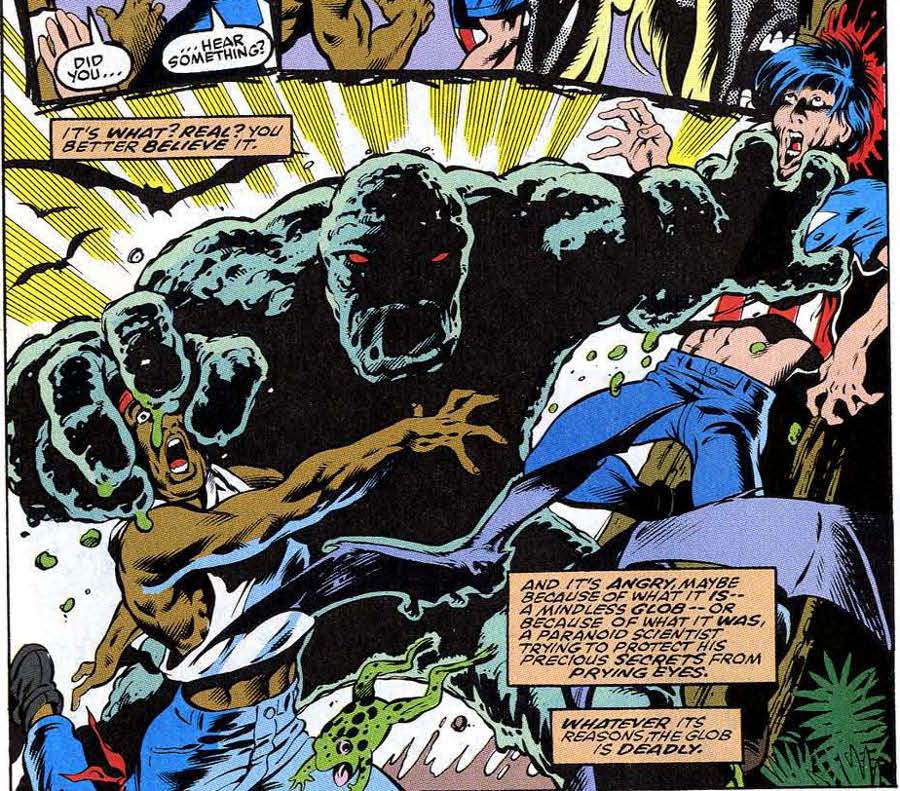 This time the Glob, which is not as noble as Timms, serves as a foil to Man-Thing. Although they are both hideous swamp creatures, the Man-Thing isn’t out to kill. The Glob is. And in contrast to the previous team-up, this time the Glob squares off against the Hulk and Man-Thing. Like many stories in which the Man-Thng guest stars, the fight ends with the Man-Thing burning whatever knows fear. In this case, the Glob lights up like a Christmas tree.
This time the Glob, which is not as noble as Timms, serves as a foil to Man-Thing. Although they are both hideous swamp creatures, the Man-Thing isn’t out to kill. The Glob is. And in contrast to the previous team-up, this time the Glob squares off against the Hulk and Man-Thing. Like many stories in which the Man-Thng guest stars, the fight ends with the Man-Thing burning whatever knows fear. In this case, the Glob lights up like a Christmas tree.Ultimately, the Glob’s presence in the story is minimal, only on seven pages out of a thirty page story. Not a lot of time to develop itself as anything but a mindless swamp killer. Sort of like bigfoot, something that lurks in the swamp, and kills when it encounters a group of teenagers. But it is destroyed, as much as comics characters are ever destroyed, this is the last time we see the Beckwith Glob.
Fourteen years went by before the Glob resurfaced in 2006. The original, shaggy Glob is part part of Nick Fury’s Howling Commandos. They have apparently picked him up in a swamp, and are rehabilitating him. The miniseries is about an assembly of monsters who work for S.H.I.E.L.D. As part of an ensemble cast, the Glob is not given much time to develop as a character. It is the shaggy Glob again, rather than the clayey post-Gerber Glob. Unfortunately, it doesn’t hold a unique position o the team. It’s merely a strong, tough character.
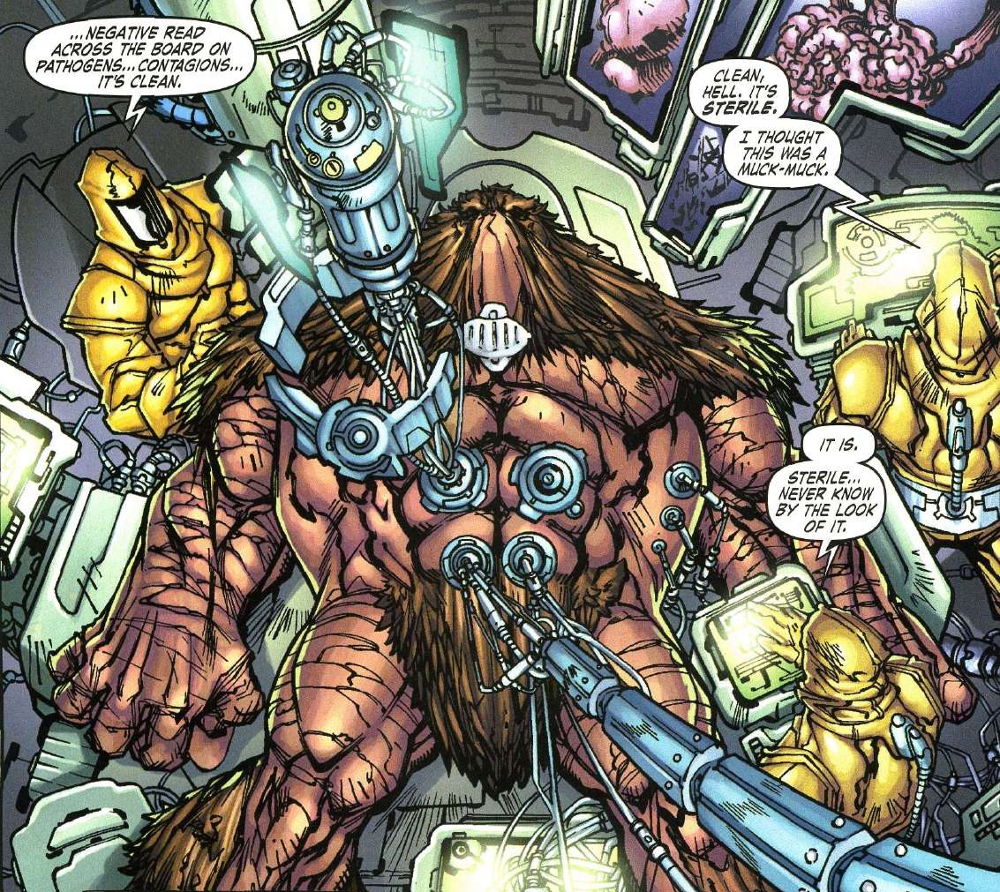 The Glob is also fitted with a communications device, so it can finally speak. This is not the mindless, mute Joe Timms that has been mentally controlled. With the speech device, it seems to be a perfectly normal human, even making jokes, under the streamers of swamp muck. But the Glob is not very taken over so many times. This is done for the Man-Thing much later. After this, he’s shuffled to the back of the pack. He only appears in a single panel of the final assault at the end of issue six.
The Glob is also fitted with a communications device, so it can finally speak. This is not the mindless, mute Joe Timms that has been mentally controlled. With the speech device, it seems to be a perfectly normal human, even making jokes, under the streamers of swamp muck. But the Glob is not very taken over so many times. This is done for the Man-Thing much later. After this, he’s shuffled to the back of the pack. He only appears in a single panel of the final assault at the end of issue six.With its creation by Roy Thomas, as well as the turns on the character from Steve Gerber and Len Wein, make the Glob a potentially interesting character. Unfortunately, it has been treated as a generic strong antagonist. In its nearly fifty year life span, the Glob hasn't yet been better developed than it was in it's initial appearance. It hasn’t proven popular, seldom appearing without the character it was born to fight: the Incredible Hulk. Roy Thomas’s initial script has a good origin, and gives the character some nuance, which has been subsequently discarded in favor of using it as a strong, durable punching bag for the Hulk, usually dominated by some villain or other. Given how much Marvel recycles its characters, there’s always a chance someone will pick up the Glob and develop it. Here's hoping.
One aspect of the character that has been interesting to me personally is the way the art has changed over the decades. With the Glob dropping off Marvel's radar entirely for decades at a time, the jump in art styles is arresting. Herb Trimpe's detailed art, delicately inked, with the muted, messy colors indicative of the printing process marvel was using at the time. Gary Barker's art in Incredible Hulk 389 is less detailed, concentrating more on the characters, less on the background, the coloring process giving us much brighter colors.
All images Copyright Marvel comics.
Next up, the first of three characters that appeared in 1971. The least famous one, in fact.
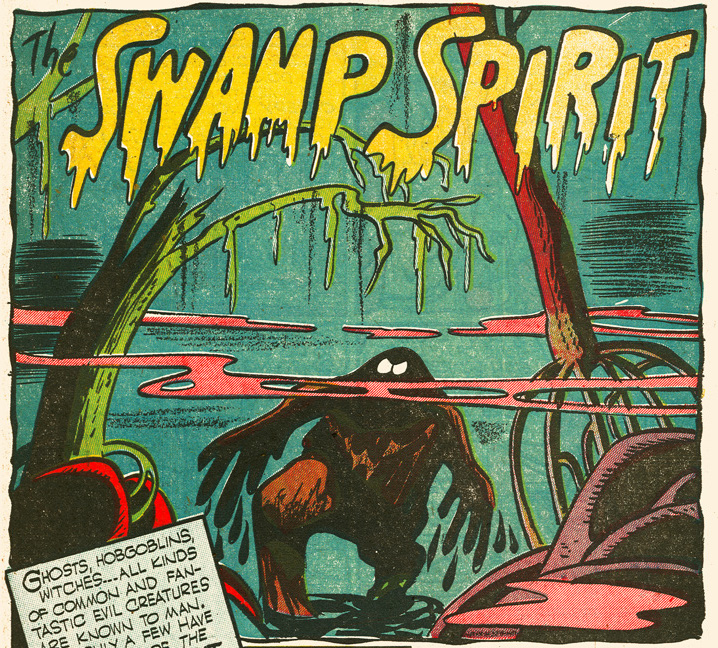 I was going to make a different blog post, but I turned it into an article for MONSTER! magazine. If I can convince them that they want a series of muck monster articles, I'll probably have to stop writing them here. But that's neither here nor there right now. During, and just after the Heap’s publication run, two satires of the Heap appeared.
I was going to make a different blog post, but I turned it into an article for MONSTER! magazine. If I can convince them that they want a series of muck monster articles, I'll probably have to stop writing them here. But that's neither here nor there right now. During, and just after the Heap’s publication run, two satires of the Heap appeared. 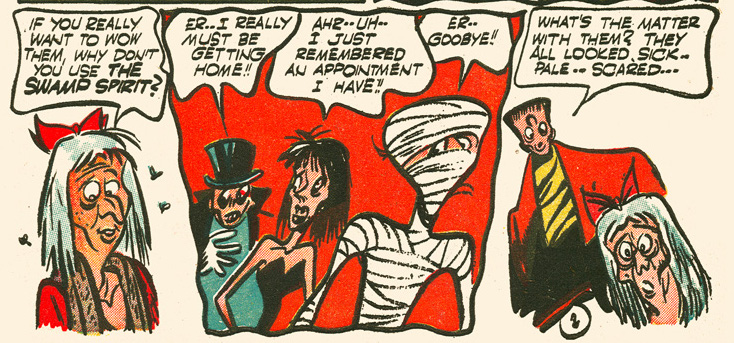
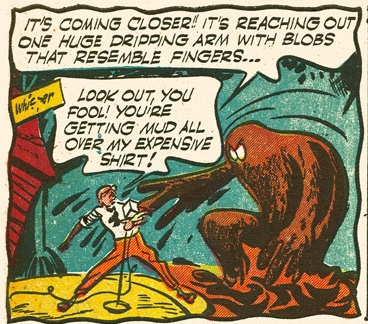
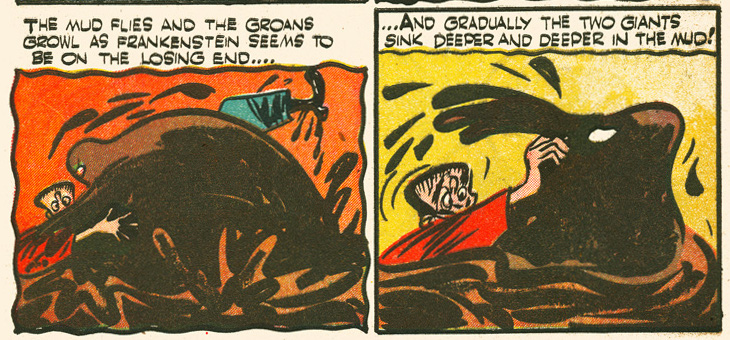
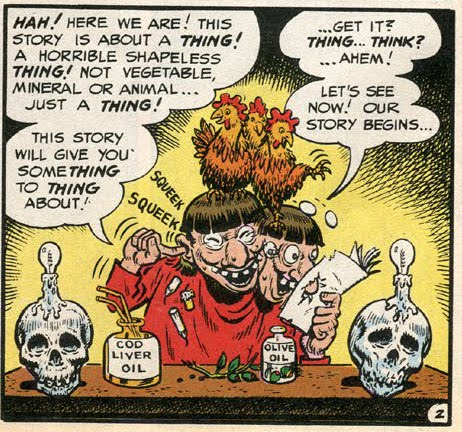 Bill Elder, one of the seminal and most influential artists in Mad magazine, wrote and drew the story which clearly reflects its EC comics heritage. It is bookended by an EC-style host, Ramon, and contains many of Elder's trademark sight gags. The story is jammed with them, down to messages changing between panels.
Bill Elder, one of the seminal and most influential artists in Mad magazine, wrote and drew the story which clearly reflects its EC comics heritage. It is bookended by an EC-style host, Ramon, and contains many of Elder's trademark sight gags. The story is jammed with them, down to messages changing between panels.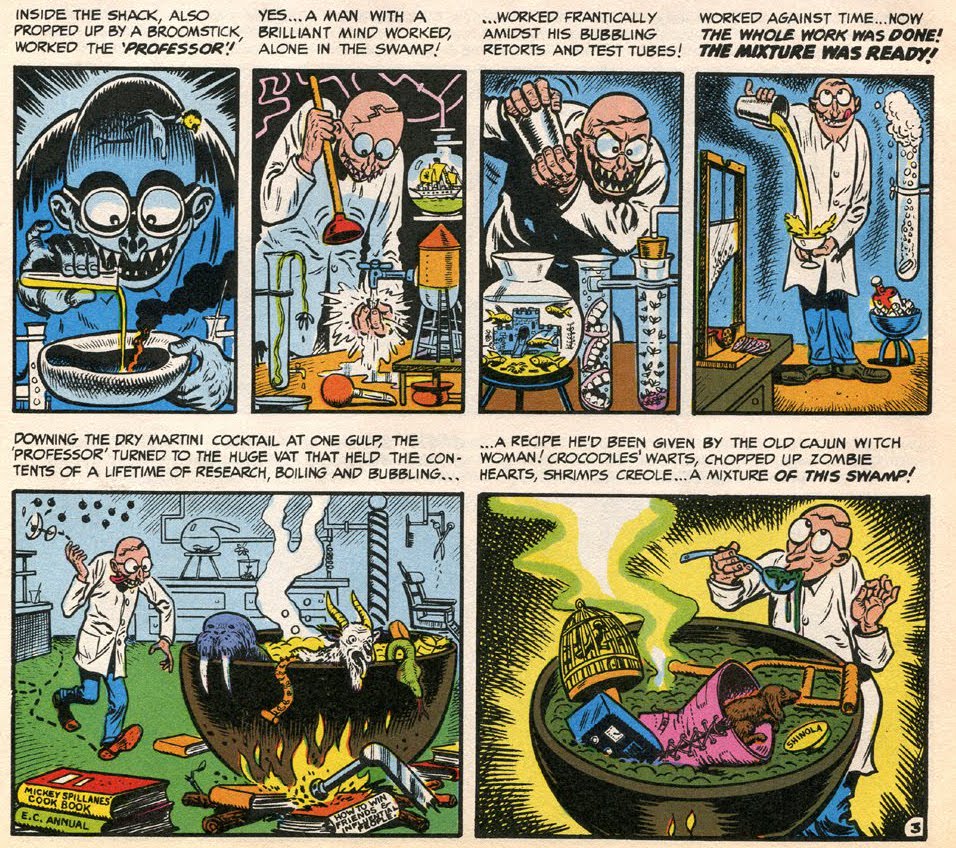
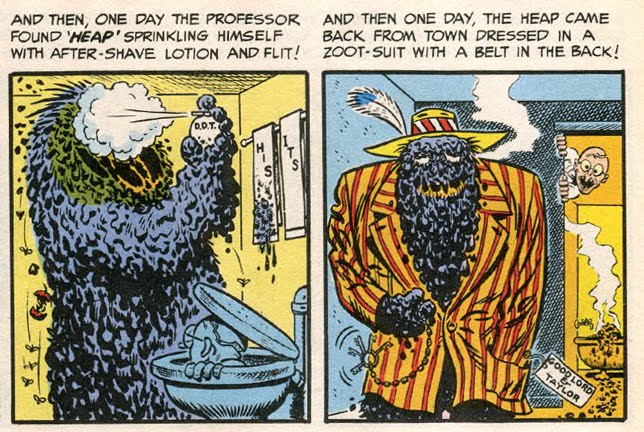
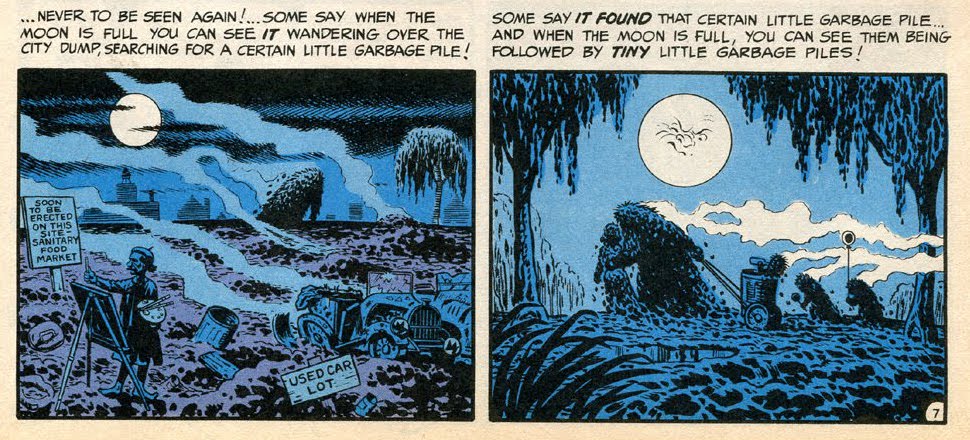
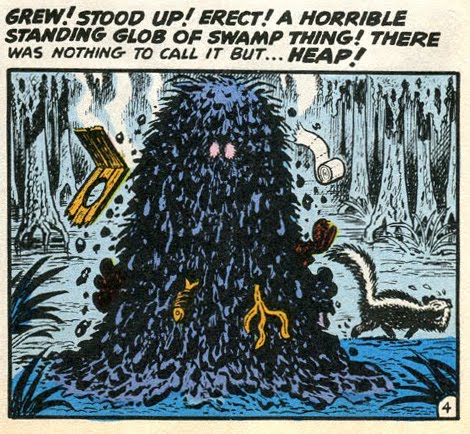 This would be a minor footnote if it weren't for this famous panel: Here we have two names for future offshoots of the Heap; Glob and Swamp Thing. At only eight pages, this story is so seminal and informs a lot of what comes later. The introduction of the catalyst, the oddly prophetic names as the Heap emerged from the swamp, and the more human emotional maturity of the Heap are all notable in subsequent swamp monsters. Undoubtedly, this story is ore widely read than the Frankenstein Swamp Spirit story, and likely has a wider audience than the original Airboy Comics. While Airboy has had a notable resonance with writers, Mad magazine has been reprinted and read pretty consistently since its initial publication.
This would be a minor footnote if it weren't for this famous panel: Here we have two names for future offshoots of the Heap; Glob and Swamp Thing. At only eight pages, this story is so seminal and informs a lot of what comes later. The introduction of the catalyst, the oddly prophetic names as the Heap emerged from the swamp, and the more human emotional maturity of the Heap are all notable in subsequent swamp monsters. Undoubtedly, this story is ore widely read than the Frankenstein Swamp Spirit story, and likely has a wider audience than the original Airboy Comics. While Airboy has had a notable resonance with writers, Mad magazine has been reprinted and read pretty consistently since its initial publication.